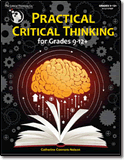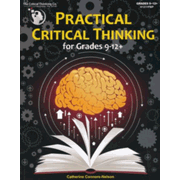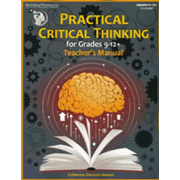Practical Critical Thinking for Grades 9-12+ is an introductory course in critical thinking for teens that builds from very basic concepts up through fairly sophisticated applications. While it is written for high school students, I expect many junior high students can easily complete the course as well.
The course has four units with two chapters per unit. Each chapter has from seven to eleven sub-sections, each of which will likely serve as one day’s lesson. That means that by completing about two lessons per week, the course will take one school year to finish.
The first unit, “Becoming a Critical Thinker,” begins with open-ended exercises that challenge students to consider what critical thinking is, how it applies in their own lives, and obstacles such as peer pressure and emotions that can derail critical thinking.
The second chapter in this unit uses puzzles—including some from other books from the same publisher—to help students practice critical thinking skills in different types of applications.
Unit 2, “Adding to My Critical Thinking Toolbox,” continues to lay the foundation. While students should already have learned the difference between fact and opinion, the next chapter begins with a refresher on facts and opinions then pushes students to think through evidence and whether or not it makes conclusions possible, probable, or proven. This chapter concludes with some interesting exercises to stimulate creative thinking.
The second chapter in this unit addresses “Critical Thinking and Language,” discussing topics such as emotionally charged words, ambiguity, vagueness, euphemisms, and jargon.
You can see how this sequence of lessons lays the groundwork for critical thinking skills. Some students might have already studied some of these topics, and you might be able to skip some sections, but don’t do so unless you are certain that students are proficient in that area.
The third unit, “Critical Thinking and Arguments,” explains the nature of an argument and goes on to explain the difference between inductive and deductive arguments. The second chapter in this unit introduces informal fallacies.
The fourth unit, “Applying My Critical Thinking,” dedicates an entire chapter to advertising. Its goal is to teach students to apply critical thinking to the advertising that bombards them, to understand advertising techniques, to understand informal fallacies in ads, and to consider the pros and cons of advertising.
The final chapter, “Eyewitness Testimony, Direct & Circumstantial Evidence,” exposes students to applications in critical thinking in legal situations and in some fascinating experiments. This last unit, in particular, uses examples from the news and popular culture that will likely be particularly interesting to students.
The course can be used by a single student or a group class. Every chapter concludes with “Group Activities and Discussion,” but the author directs individual homeschoolers to simply do these with a parent. If you are completing two lessons per week, the discussion period would occur about once a month.
The lesson material is only in the student book while the companion teacher’s manual has an answer key plus reproducible pages for all student worksheets. A teacher can teach from the student book, printing out the pertinent reproducible pages for students to look at and then complete. This seems to me the most likely scenario for a group class since student books are the priciest component. However, the student book is printed in full color while the teacher’s manual is black-and-white, and that might make a difference to some students.
I think the course is likely to be most enjoyable if students can meet for a group class for end-of-chapter interaction and discussion. However, if individual homeschooling students work through the student book on their own, their parents will also probably need to read the material to be prepared for the discussion and interaction at the end of each chapter. The answer key has specific answers for some exercises, but many questions do not have specific answers. In these cases, the separate teacher's manual suggests key ideas or concepts that students should address. This help might be sufficient for parents without requiring them to read the entire chapter, but I think this is something that will vary from parent to parent.
Lessons incorporate unique learning tools such as thought experiments, student polls (self-reflection rather than polling other students), puzzles, and continually changing activities and exercises. The combination of self-reflection and practical application with loads of creative learning activities should make Practical Critical Thinking a favorite course for teens.










